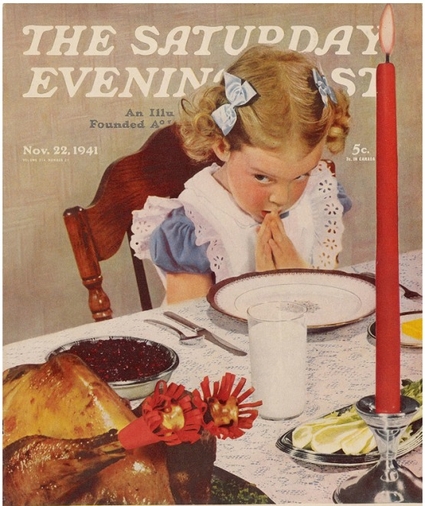
If Thanksgiving were just about Pilgrims, the Mayflower, and exhortations to gratitude, it would never have become the most cherished American holiday after Christmas. Our calendars are replete with National This Day and National That Week, most of which never merit a moment's thought. Even some of our official American holidays mean little more to us than taking the day off and seeing ads for cars. Does anyone get emotional when Presidents Day comes around? Or travel hundreds of miles to be with family on Columbus Day?
What gives Thanksgiving its intensity and significance are its rituals — above all the tradition of joining loved ones in a holiday feast. "For more than 200 years, Americans have been sitting down to the same meal on Thanksgiving Day: roast turkey with stuffing, cranberry sauce, potatoes, and one or more kinds of pie," writes Melanie Kirkpatrick in her 2016 book Thanksgiving. The holiday isn't called "turkey day" for nothing: According to Consumer Reports, on Thanksgiving a whopping 88 percent of American households serve turkey — more than 50 million of them in 2017.
Food and eating traditions are powerful. The tradition of turkey dinner on Thanksgiving represents more to Americans than just a familiar meal. It symbolizes prosperity. Sociologists have made much of the ritual of preparing, serving, and (over)eating great amounts of food on Thanksgiving. In the words of scholars Melanie Wallendorf and Eric Arnould, what Americans' heaping quantities of turkey and stuffing celebrate is "not just a moment of bounty but a culture of enduring abundance."
The most iconic depiction of that message is not in a sociological tome, but in Norman Rockwell's classic 1943 painting, Freedom from Want, which shows an extended family assembled for Thanksgiving dinner as a noble roasted turkey is being brought to the table.
Yet abundance is not everyone's lot, and never has been. That was a theme addressed by Langston Hughes in one of his very first published short stories, "Those Who Have No Turkey." It's the tale of Diane Jordan, a young Ohio farm girl, who comes to spend Thanksgiving — "sometimes called the Day of Big Dinners," as Hughes writes — with the family of her prosperous Aunt Ruth in Cleveland. It is Diane's first visit to a big city, and when she heads out before dinner to walk around, she encounters a newsboy eager to sell his last papers.
"You're in a hurry to get home and eat some turkey, aren't you?" the girl asks.
"Turkey! What do yuh mean?" replies the boy. "We ain't got no turkey."
His answer baffles Diane. "The girl could not imagine anyone not having turkey for Thanksgiving. All the people in the country had one. Truly, city ways were strange!" She imagines that the boy's family must prefer duck or chicken to turkey, and is astonished to find out that his family isn't planning any kind of feast. "It took her a long time to comprehend. She had never heard of anybody having nothing for dinner."
When Diane impulsively invites the newsboy to bring his family to Aunt Ruth's fine home for Thanksgiving dinner, it is his turn to be confused.
"The newsie was rather puzzled at the strange girl's generosity. Nothing like this had ever happened to him before and he had sold papers in the streets since the age of three." He accepts the invitation. For the first time in his life, he experiences a typical American Thanksgiving, gorging himself on turkey and pie.
Thanksgiving is indeed our "Day of Big Dinners." The turkey-dinner ritual is deeply rooted and disregarding the tradition upsets the natural order. "What kind of Thanksgiving dinner is this?" Pumpkin Patty demands indignantly of Charlie Brown in a somewhat more recent classic of holiday fiction than Hughes's story. "Where's the turkey, Chuck? Don't you know anything about Thanksgiving dinners? Where's the cranberry sauce? Where's the pumpkin pie?"
As important as the feast is to the holiday, however, it would be a travesty to reduce Thanksgiving to mere biological consumption. Langston Hughes, Norman Rockwell, and "A Charlie Brown Thanksgiving" couldn't be more unalike, yet all three convey the same message. At the heart of our Thanksgiving rituals are sharing and community. The holiday's essence isn't expressed in the meal; it is that we gather together for the meal. We refer to Thanksgiving as "turkey day," but a more accurate nickname would be "turkey day — with others."
For the bird, in the end, is optional. Not so the presence of loved ones or guests. Thanksgiving on your own isn't Thanksgiving.
Sign up for the daily JWR update. It's free. Just click here.
(COMMENT, BELOW)


 Contact The Editor
Contact The Editor
 Articles By This Author
Articles By This Author